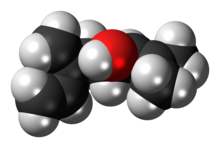(S)-Ipsdienol
Appearance

| |

| |
| Names | |
|---|---|
| IUPAC name
(4S)-2-methyl-6-methylideneocta-2,7-dien-4-ol
| |
| Other names
(S)-(+)-Ipsdienol, 2-Methyl-6-methylene-2,7-octadiene-4-ol, Ipsdienol
| |
| Identifiers | |
3D model (JSmol)
|
|
| ECHA InfoCard | 100.128.974 |
PubChem CID
|
|
CompTox Dashboard (EPA)
|
|
| |
| Properties | |
| C10H16O | |
| Molar mass | 152.237 g·mol−1 |
| Appearance | Colorless |
| Hazards | |
| Flash point | 87 °C (189 °F; 360 K) |
Except where otherwise noted, data are given for materials in their standard state (at 25 °C [77 °F], 100 kPa).
| |
(S)-Ipsdienol is a terpene alcohol. It is one of the major aggregation pheromones of the bark beetle. It was first identified from Ips confusus, in which it is believed to be a principle sex attractant.[1]
It is suggested that the compound plays a role in interspecies communication between Ips latidens and Ips ini, facilitiating reductions in competition for breeding material and/or mating interference.[2]
Synthesis
The compound has been synthesized from D-mannitol.[3]
References
- ^ Silverstein, Robert M; Rodin, J. Otto; Wood, David L. (October 1966). "Sex Attractants in Frass Produced by Male Ips confusus in Ponderosa Pine". Science. 154 (3748): 509–510. Bibcode:1966Sci...154..509S. doi:10.1126/science.154.3748.509. JSTOR 1720044.
{{cite journal}}: Unknown parameter|doi_brokendate=ignored (|doi-broken-date=suggested) (help) - ^ Miller, Daniel R.; Borden, John H.; King, G. G. S.; Slessor, Keith N. (1 August 1991). "Ipsenol: an aggregation pheromone for Ips latidens (Leconte) (Coleoptera: Scolytidae)". Journal of Chemical Ecology. 17 (8): 1517–1527. doi:10.1007/BF00984685. PMID 24257877.
- ^ Hanessian, Stephen (1983). Total Synthesis of Natural Products: The 'Chiron' Approach. Pergamon press. p. 63. ISBN 978-0-08-029247-2.
